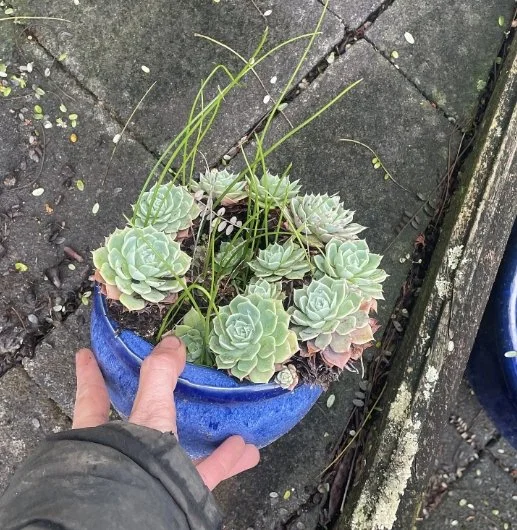There are native orchids growing in your plant pots
Agh, my head is full of plans and workarounds on how to get multiple trees from multiple nurseries onto multiple sites- all next week and somewhat all at once.
What I am obsessed with this week (other than a persistent obsession with forklift operators)
My poor partner can operate a forklift. He has helped me to realise that forklifts are the tugboats of the land (my analogy, pretty inaccurate overall) and that I can’t just summon one to do what I want because they are so darn heavy. Turns out that they are heavily weighted at the back so that they don’t topple over when lifting heavy things. This means I am not allowed to just summon a forklift to carry a 200kg tree across a parking lot and over a lawn. Humpf.
Plantwise! Have you got a load of these guys growing in your pots?
I swear I have a normal hand.
Live in NZ? Yes? They are NATIVE ORCHIDS. Microtis unifolia. The Common Onion Orchid. And here you were weeding them all out.
Let’s make sure we are all talking about the same plant for a second- here is the root base.
M. Unifolia is so common that, well, we always weed them out. They love a good plant pot. They turn up everywhere.
There are three other species of similar orchid in NZ and the one local to Wellington is regionally, critically, endangered.
Microtis oligantha (left) and M. unifolia (right), showing differences in the number of flowers and length of the floral spike. Photo by Ben Carson. Source
So, if you see an orchid with a flower spike like the one on the right hand side- common as mud. If you see an orchid with a flower spike like the one on the left- this is a critically endangered orchid. Please leave it alone. Offer it a cup of tea, or something!
Te Papa is conducting some interesting research into these orchids, you can find a bit of a write up here.
Now this begets the question- what do I do when I see a huge load of native orchids in a client’s garden? I feel like a bit of a brute, pulling them all out!
Maybe I will make up tiny little label spikes to put beside them stating that they are native orchids?
Right now, I’m weeding where I need to, and leaving where I can get away with it. Unfortunately for whatever reason these orchids love plant pots more than soil, so we have to weed more often than not… What do you do?
What we are up to this week
We are landscaping, across three different sites. I am calm(ish). I cannot recommend enough that people use Snapchat and Facebook Messenger in order to communicate with one another when it comes to garden planning. I ran around one job the other day on snapchat, see below-
I just ‘save’ instead of ‘send’ when I’ve taken the photos, and then send them on Whatsapp or FB messenger when staff arrive. On those two apps, you can both scribble all over the photos as needed (if you need to put in arrows or circle things for clarity). Anyway- highly recommend.
Aside from our cellphone use, we are mulching everywhere we possibly can. August and September are the times when the weeds haven’t started to grow yet, and you can put down a thick enough layer of mulch to get you through to January without the weeds being able to get through. Any earlier and the mulch can shift/degrade too quickly and you end up with weedy beds in Spring. I recommend mulching, mulching, mulching at this time of year.
We are finishing up on pruning the hydrangeas, and have started pruning roses. We are finishing up on pruning the fruit trees and are NOT pruning stonefruit any more- they can only be pruned in the dead of Winter (or the heat of midsummer) or they may get a fungal infection called silver leaf.
We ARE spraying with copper and sulfur in the few places we really need to- this needs to be done before budburst so if you are a person who sprays fruit trees with copper or sulfur this is your curtain call.
We know that the warmest place to be at this time of year is in the garden, where we are running around keeping everything ticking over :) Join us this weekend if it isn’t blowing a gale!




